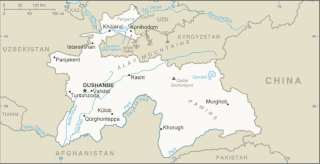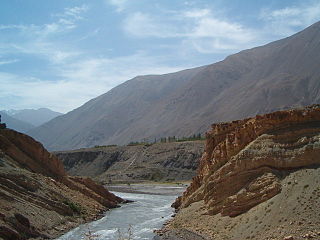It is proposed that this article be deleted because of the following concern:
If you can address this concern by improving, copyediting, sourcing, renaming, or merging the page, please edit this page and do so. You may remove this message if you improve the article or otherwise object to deletion for any reason. Although not required, you are encouraged to explain why you object to the deletion, either in your edit summary or on the talk page. If this template is removed, do not replace it . The article may be deleted if this message remains in place for seven days, i.e., after 10:40, 18 February 2022 (UTC). Find sources: "Index of Tajikistan-related articles" – news · newspapers · books · scholar · JSTOR Nominator: Please consider notifying the author/project: {{ subst:proposed deletion notify |Index of Tajikistan-related articles|concern=This type of list can be considered depecrated, per [[Wikipedia:Articles for deletion/Index of Brazil-related articles|this]], [[Wikipedia:Articles for deletion/Index of China-related articles|this]], [[Wikipedia:Articles for deletion/Index of India-related articles|this]], [[Wikipedia:Articles for deletion/Index of Pakistan-related articles|this]], [[Wikipedia:Articles for deletion/Index of Romania-related articles|this]], [[Wikipedia:Articles for deletion/Index of Sri Lanka-related articles|this]] and [[Wikipedia:Articles for deletion/Index of Afghanistan-related articles|this]] AFD - and now also [[Wikipedia:Articles for deletion/Index of Myanmar-related articles (2nd nomination)|this]] and [[Wikipedia:Articles for deletion/Index of Albania-related articles|this]] AFD.}} ~~~~ |
Articles (arranged alphabetically) related to Tajikistan include:

Tajikistan, officially the Republic of Tajikistan, is a landlocked country in Central Asia. It has an area of 143,100 km2 (55,300 sq mi) and an estimated population of 9,537,645 people. Its capital and largest city is Dushanbe. It is bordered by Afghanistan to the south, Uzbekistan to the west, Kyrgyzstan to the north and China to the east. The traditional homelands of the Tajik people include present-day Tajikistan as well as parts of Afghanistan and Uzbekistan.

Tajikistan harkens to the Samanid Empire (819–999). The Tajik people came under Russian rule in the 1860s. The Basmachi revolt broke out in the wake of the Russian Revolution of 1917 and was quelled in the early 1920s during the Russian Civil War. In 1924 Tajikistan became an Autonomous Soviet Socialist Republics of the Soviet Union, the Tajik ASSR, within Uzbekistan. In 1929 Tajikistan was made one of the component republics of the Soviet Union – Tajik Soviet Socialist Republic – and it kept that status until gaining independence 1991 after the dissolution of the Soviet Union.

Tajikistan is nestled between Kyrgyzstan and Uzbekistan to the north and west, China to the east, and Afghanistan to the south. Mountains cover 93 percent of Tajikistan's surface area. The two principal ranges, the Pamir Mountains and the Alay Mountains, give rise to many glacier-fed streams and rivers, which have been used to irrigate farmlands since ancient times. Central Asia's other major mountain range, the Tian Shan, skirts northern Tajikistan. Mountainous terrain separates Tajikistan's two population centers, which are in the lowlands of the southern and northern sections of the country. Especially in areas of intensive agricultural and industrial activity, the Soviet Union's natural resource utilization policies left independent Tajikistan with a legacy of environmental problems.

The Demographics of Tajikistan is about the demographic features of the population of Tajikistan, including population growth, population density, ethnicity, education level, health, economic status, religious affiliations, and other aspects of the population.

Most of rugged Tajikistan's transportation system was built during the Soviet era, and since that time the system has deteriorated badly because of insufficient investment and maintenance. In 2013, Tajikistan, like many of the other Central Asian countries, was experiencing major development in its transportation sector. Beginning in 2005, a series of major transportation projects were begun. The first such project, the Anzob Tunnel, was inaugurated in 2006, providing a year-round road link from Dushanbe to northern Tajikistan.

Tajiks are a Persian-speaking Iranian ethnic group native to Central Asia, living primarily in Afghanistan, Tajikistan, and Uzbekistan. Tajiks are the largest ethnicity in Tajikistan, and the second-largest in Afghanistan and Uzbekistan. They speak varieties of Persian, a Western Iranian language. In Tajikistan, since the 1939 Soviet census, its small Pamiri and Yaghnobi ethnic groups are included as Tajiks. In China, the term is used to refer to its Pamiri ethnic groups, the Tajiks of Xinjiang, who speak the Eastern Iranian Pamiri languages. In Afghanistan, the Pamiris are counted as a separate ethnic group.

Dushanbe is the capital and largest city of Tajikistan. As of January 2020, Dushanbe had a population of 863,400 and that population was largely Tajik. Until 1929, the city was known in Russian as Dyushambe, and from 1929 to 1961 as Stalinabad, after Joseph Stalin. Dushanbe is located in the Gissar Valley, bounded by the Gissar Range in the north and east and the Babatag, Aktau, Rangontau and Karatau mountains in the south, and has an elevation of 750–930 m. The city is divided into four districts, all named after historical figures: Ismail Samani, Avicenna, Ferdowsi, and Shah Mansur.

Bokhtar, previously known as Qurghonteppa or Kurganteppa, is a city in southwestern Tajikistan, which serves as the capital of the Khatlon region. Bokhtar is the largest city of southern Tajikistan, and is located 100 kilometres (62 mi) south of Dushanbe and 150 kilometres (93 mi) north of Kunduz, Afghanistan.

Khujand, sometimes spelled Khodjent and known as Leninabad from 1936 to 1991, is the second-largest city of Tajikistan and the capital of Tajikistan's northernmost Sughd province.

The Kuhistani Badakhshan Autonomous Region is an autonomous region in eastern Tajikistan, in the Pamir Mountains, which makes up 45% of the land area of the country, but only 3% of its population.

The Zeravshan is a river in Tajikistan and Uzbekistan, Central Asia. Its name, "spreader of gold" in Persian, refers to the presence of gold-bearing sands in the upper reaches of the river. To the ancient Greeks it was known as the Polytimetus. It was also formerly known as Sughd River. The river is 877 kilometres (545 mi) long and has a basin area of 17,700 square kilometres (6,800 sq mi).

The Tajikistani Civil War, also known as the Tajik Civil War, began in May 1992 when regional groups from the Garm and Gorno-Badakhshan regions of Tajikistan rose up against the newly-formed government of President Rahmon Nabiyev, which was dominated by people from the Khujand and Kulob regions. The rebel groups were led by a combination of liberal democratic reformers and Islamists, who would later organize under the banner of the United Tajik Opposition. The government was supported by Russian border guards.

Sughd Province is one of the four administrative divisions and one of the three provinces that make up Tajikistan. Centered in the historical Sogdiana, it is located in the northwest of the country, with an area of some 25,400 square kilometers and a population of 2,707,300, up from 2,233,550 according to the 2010 census and 1,871,979 in 2000. The capital is Khujand. The Province's ethnic composition in 2010 was 84% Tajik, 14.8% Uzbek, 0.6% Kyrgyz, 0.4% Russian and 0.1% Tatar.

Bobojon Ghafurov or Babadzan Gafurovich Gafurov was a Tajik historian, academician, and the author of several books published in Russian and Tajik, including History of Tajikistan and The Tajiks.

The Pamiris are an Eastern Iranian ethnic group who are native to the Gorno-Badakhshan Autonomous Region of Eastern Tajikistan, the Badakhshan Province of Northeastern Afghanistan, the Taxkorgan Tajik Autonomous County in Xinjiang, China and Hunza Valley in Pakistan.

Rudaki District is a district in Tajikistan, one of the Districts of Republican Subordination. It stretches south from Dushanbe, bordering on Shahrinav District, the city of Hisor, and Varzob District from the north and northwest, Tajikistan's Khatlon Region from the south and the east, and Uzbekistan from the west. Its administrative capital is Somoniyon, a southern suburb of Dushanbe, called Leninsky in the Soviet period. The population of the district is 518,200.
In parallel to what happened in other Soviet republics, a cinema of Tajikistan was promoted by the Soviet state, and declined in the first years after the independence, before being revitalized through the efforts of the new government.
The Gurminj Museum of Musical Instruments is a museum located in the center of Dushanbe, Tajikistan, behind the Office of the Mayor on Bokhtar Street.

The Zarafshan Range is a mountain range in Tajikistan and Uzbekistan, part of the Pamir-Alay mountains. Almost all of the range belongs to the drainage basins of the Zarafshan River.